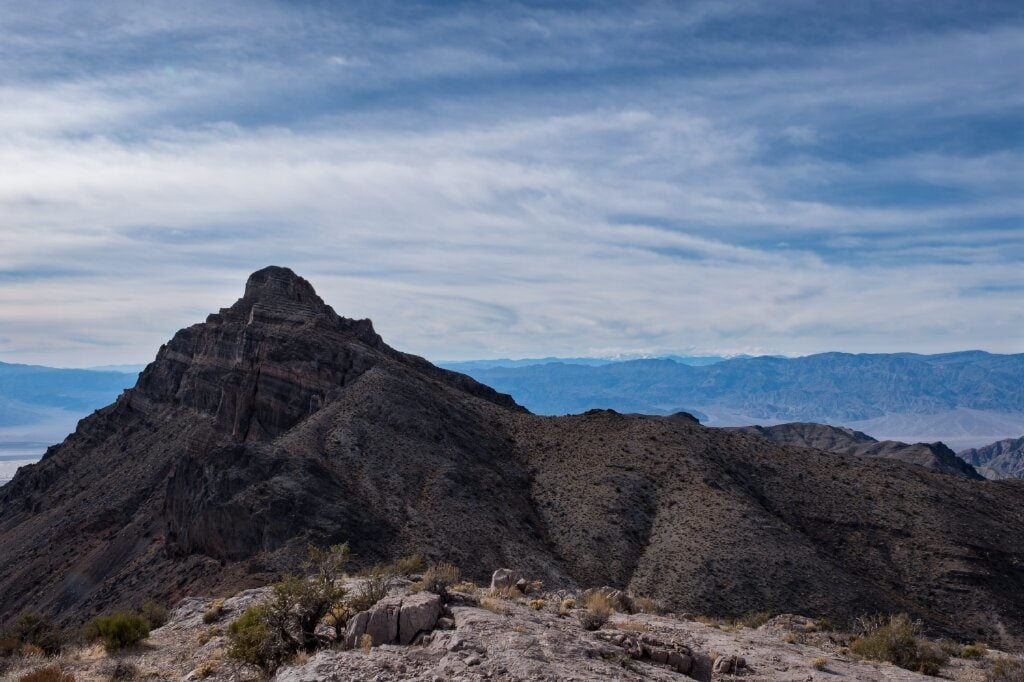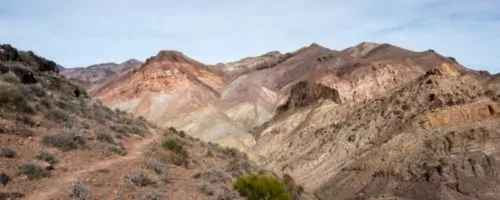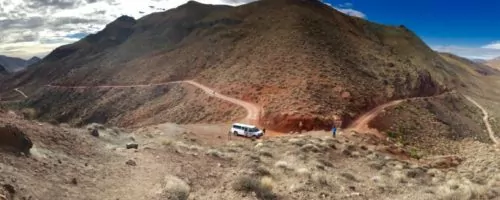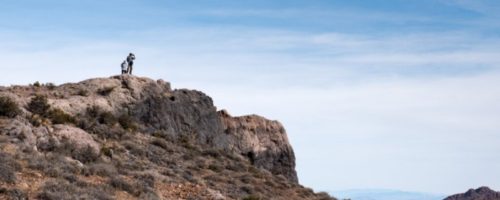
Thimble Peak Trail
General Description
If you happen to be taking a drive on the amazing Titus Canyon Road, then why not take a break and bag an equally amazing peak. At just 5 miles round trip and a little over 1300 feet of total elevation gain, Thimble Peak Trail is the best high return hike for minimal effort in Death Valley National Park. The trail begins on the south side of Red Pass (you’ll know when you get there). From here, follow the well-worn path up the ridgeline to the base of Thimble’s sheer limestone cliffs. It may look intimidating initially, but the path is a series of careful switchbacks straight up the northern ridge. From the summit, the outstanding views rival those from even Telescope Peak. Although it is a relatively tame hike, exercise extreme caution on the final approach as it involves some steep, loose, and partially exposed scrambles. Enjoy the view!
Explore Death Valley with Expert Guides
Getting to the Thimble Peak Trailhead
If you are headed to the Thimble Peak Trail, there’s only one way to get there. Turn onto the one-way Titus Canyon Road near the town of Beatty, NV. After a rough and rocky 12.5 mile drive, the road climbs to the aptly named Red Pass. There are a select few turnout spots at Red Pass, and they are rarely ever occupied. The Thimble Peak Trail is located on the left (South/West) side of the road. If you hit the ghost town of Leadfield, you’ve gone too far!

3 Best Day Hikes Near the Thimble Peak Trail
The Thimble Peak Trail is a thrilling hike and a great way to stretch your legs on the long drive through the Titus Canyon Road. Take a look at these other excellent nearby trails.
| Destination | Miles | Elev | Difficulty | Style | |
| Titus Canyon | N/A | N/A | Easy | Out and Back | |
| Fall Canyon Trail | 6 mi | 1500 ft | Moderate | Out and Back | |
| Ubehebe Crater Trail | 0.5-2 mi | 300-1000 ft | Easy-Moderate | Out and Back or Loop |
1. Titus Canyon
Titus Canyon is one of the deepest and most awe-inspiring canyons found in Death Valley National Park. If you’re up for an incredibly scenic back country road, drive the 27 mile Titus Canyon Road, a narrow, twisting, one-way thrill ride. A high clearance vehicle will take adventurers up to the vibrantly colored hills of Red Pass. From here take a hike to nearby Thimble Peak, or descend into the Leadfield ghost town. Beyond Leadfield lies the lush Klare Spring and ancient Native American Petroglyphs. No high clearance? No problem! Hikers can stroll up the 1.5 miles of Titus Canyon’s astounding narrows, in some places only 20 feet wide and hundreds of feet deep. Check out nearby Fall Canyon if you are looking to put in a few more miles of hiking. However you choose to explore, Titus Canyon is a must do for any trip to Death Valley National Park.
2. Fall Canyon Trail
Easy access, gentle grade, and colorful canyon walls extending 2000 feet above make Fall Canyon an outstanding hike in Death Valley National Park. Dropping into the wide wash of Fall Canyon, you will immediately know that you are in for something big. Along the hike, the canyon walls display vibrant reds, whites, blacks, and greys of geologic strata uplifted at varying angles. Wind your way up canyon passing intriguing side canyons to the base of a 20 foot dry fall. For most, the adventure stops here. A short stroll back will reveal a short slope scramble to bypass the falls on the south side. Adventurous souls will be treated to a beautiful section of narrows above the dry fall. The stunning narrows of lower Titus Canyon are a great way to add on a few miles. Whatever you fancy, Fall Canyon is a sure bet for a great hike.
3. Ubehebe Crater Trail
Ubehebe Crater is a stunning testament to Death Valley’s violent volcanic past. At 600 feet deep and one half mile across, Ubehebe is the largest of a series of craters that pockmark the area. Take a walk along the loop trail at the rim of the crater and explore several other samaller, more eroded craters. From the high point along the rim, observe the massive blanket of grey-black cinder; the result of Ubehebe’s eruption. Another great way to experience the enormity of Ubehebe is to take the short but steep trail to the bottom of the crater. Although the 600 feet of elevation gain to come back up doesn’t sound like much, it can seem twice as far when hiking up the steep, loose cinder trail. Hikers of all ages and abilities are sure to have a blast at Ubehebe Crater.
Maximize Your Visit to Death Valley National Park on a Hiking Tour
Guided multi-day packages allow visitors the opportunity to make the most of their time in Death Valley National Park and to do it hassle-free. Guided tours include gear (backpack, trekking poles, crampons in winter), meals, accommodations, local transportation, and a professional Death Valley hiking guide. Through their knowledge, stories, and personal passion, guides can bring a place to life in a way that’s much more difficult to do on your own. Read more about Death Valley Hiking Tours.
Award Winning USA Hiking Vacations

More Great Peak Hikes
| Destination | Miles | Elev | Difficulty | Style | |
| Wildrose Peak | 8.4 mi | 2200 ft | Moderate | Out and Back | |
| Telescope Peak | 12 mi | 3300 ft | Strenuous | Out and Back | |
1. Wildrose Peak
Wildrose Peak Trail is perfect for the weekend peak bagger or anyone seeking a challenging day hike. The trailhead starts at the beautifully preserved historic Charcoal Kilns. From here, hikers follow the remnants of the old logging road to a saddle to stunning views of the Badwater Basin salt flats. Take a minute to catch that second wind before the steep ascent to the summit. A series of tight switchbacks wind their way up the side of the mountain in full view of the valley floor over 8000 feet below. Enjoy a few moments of triumph at the summit just over 9000 feet above sea level. A sweeping panorama reveals Death Valley stretching east and north, Telescope and Rogers peaks towering to the south, and the mighty Sierra Nevada to the west. Write a few inspiring words in the summit register, and enjoy the views.
2. Telescope Peak
A hike to the magnificent Telescope Peak is a challenging thrill ride that is sure to get your heart pumping. The highest point in Death Valley National Park, Telescope peak stands over 11,300 feet above the valley floor just 7 miles east. You would literally have to be in an airplane to be so far above the ground! The trail begins at Mahogany Flat where hikers catch their first views back into Badwater Basin over 8000 feet below. Hike around Rogers and Bennett Peaks, taking in views of the Eastern Sierras to the west. Breathe deep and take your time up the 13 steep switchbacks to the final ridgeline to the breathtaking summit. Be sure to sign the summit register and take time to admire the stunning 360 panorama and celebrate your victory. You’ve earned it.
Join a Guided Death Valley National Park Backpacking Trip
Joining a Death Valley backpacking tour is a worry-free, adventurous way to experience Death Valley National Park. With your gear, meals, local transportation, permits, and fees taken care of for you, you can travel light and focus 100% on enjoying the hiking experience, while the guide company takes care of everything else. Also, by going with local experts you’ll enjoy a greater level of safety and gain a much better understanding of the history and ecology of this remarkable region. Read more about a guided Death Valley National Park backpacking trip.

When to Hike and Seasonal Considerations
The Thimble Peak Trail is best hiked from late fall through early spring. Daytime temperatures during the summer months can make this exposed hike unbearable and dangerous. Snow and ice rarely ever stick around long making this a great winter hike. Be sure to check the road conditions before setting out to conquer this peak. Titus Canyon Road is subject to closure after heavy rain events.
Necessary Permits
Day Hikes
No permits are required for day hiking in Death Valley National Park.
Backpacking Permits
Backcountry camping permits are voluntary and may be obtained at the Visitor Center or any Ranger Station. Due to the extreme environment and remoteness, it is recommended that solo hikers and backpackers provide itinerary information and emergency contacts to park personnel.
Suggested Packing List
Day Hike Packing List
- 3-4 liters of water per person
- Salty, calorie-rich snacks
- lunch
- backpack
- trekking poles
- crampons (in winter)
- wide-brimmed hat
- sunscreen, sunglasses
- cotton t-shirt (spring-fall)
- non-cotton t-shirt (winter)
- rain jacket
- warm non-cotton layer
- 1st-aid kit
Backpacking Packing List
- all items listed for day hikes PLUS
- additional water AND water filter/purification method
- multi-day backpack
- 3-season tent
- sleeping bag
- sleeping pad
- backpacking stove and fuel
- backpacking meals
- 2-3 pairs wool socks
- extra t-shirts
Please Respect Our National Parks – Leave No Trace
We strongly recommend abiding by all Leave No Trace ethics guidelines and practices so that our national parks and public lands are preserved for the enjoyment of future generations and for the people and animals who call these places home. Simple things like packing out your trash, obeying national park rules, and respecting the peace and quiet of our national park trails is a great start. If you’re going on a backpacking trip, you can read about more about the 7 Leave No Trace Principles.




